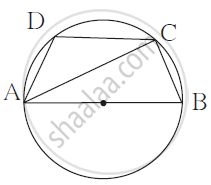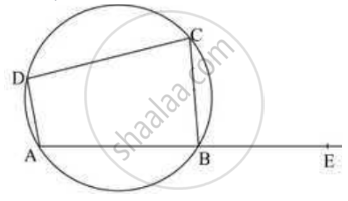Advertisements
Advertisements
Question
If non-parallel sides of a trapezium are equal, prove that it is cyclic.
Solution
Given: ABCD is a trapezium whose non-parallel sides AD and BC are equal.

To prove: Trapezium ABCD is cyclic.
Join BE, where BE || AD
Proof: Since, AB || DE and AD || BE
Since, the quadrilateral ABED is a parallelogram.
∴ ∠BAD = ∠BED ...(i) [Opposite angles of a parallelogram are equal]
And AD = BE ...(ii) [Opposite angles of a parallelogram are equal]
But AD = BC [Given] ...(iii)
From equations (ii) and (iii),
BC = BE
⇒ ∠BEC = ∠BCE ...(iv) [Angles opposite to equal sides are equal]
Also, ∠BEC + ∠BED = 180° ...[Linear pair axiom]
∴ ∠BCE + ∠BAD = 180° ...[From equations (i) and (iv)]
If sum of opposite angles of a quadrilateral is 180°, then quadrilateral is cyclic.
Hence, trapezium ABCD is cyclic.
Hence proved.
APPEARS IN
RELATED QUESTIONS
Prove that "Opposite angles of a cyclic quadrilateral are supplementary".
ABC and ADC are two right triangles with common hypotenuse AC. Prove that ∠CAD = ∠CBD.
Prove that the line of centres of two intersecting circles subtends equal angles at the two points of intersection.
Two congruent circles intersect each other at points A and B. Through A any line segment PAQ is drawn so that P, Q lie on the two circles. Prove that BP = BQ.
In any triangle ABC, if the angle bisector of ∠A and perpendicular bisector of BC intersect, prove that they intersect on the circumcircle of the triangle ABC.

In the figure, `square`ABCD is a cyclic quadrilateral. Seg AB is a diameter. If ∠ ADC = 120˚, complete the following activity to find measure of ∠ BAC.
`square` ABCD is a cyclic quadrilateral.
∴ ∠ ADC + ∠ ABC = 180°
∴ 120˚ + ∠ ABC = 180°
∴ ∠ ABC = ______
But ∠ ACB = ______ .......(angle in semicircle)
In Δ ABC,
∠ BAC + ∠ ACB + ∠ ABC = 180°
∴ ∠BAC + ______ = 180°
∴ ∠ BAC = ______
ABCD is a cyclic quadrilateral in ∠DBC = 80° and ∠BAC = 40°. Find ∠BCD.
Prove that the centre of the circle circumscribing the cyclic rectangle ABCD is the point of intersection of its diagonals.
ABCD is a cyclic quadrilateral. M (arc ABC) = 230°. Find ∠ABC, ∠CDA, and ∠CBE.

The three angles of a quadrilateral are 100°, 60°, 70°. Find the fourth angle.
